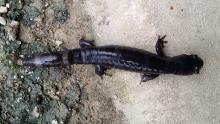Reptiles and Amphibians
Media

Species Types
Scientific Name
Notophthalmus viridescens louisianensis
Description
A small, olive-brown salamander with a fascinating life cycle, the central newt lives in and around woodland ponds and swamps in all but our far northwestern counties.
Media

Species Types
Scientific Name
Hemidactylium scutatum
Description
A glacial relict in Missouri’s eastern Ozarks, the four-toed salamander lives among mosses in heavily forested streams and creeks and sinkhole ponds. It has a thick, round tail that is constricted at its base. There are four toes on each limb.
Media

Species Types
Scientific Name
Plethodon angusticlavius
Description
The Ozark zigzag salamander is small and slender, with a narrow, somewhat lobed back stripe that can be yellow, orange, or red. This woodland species lives in Missouri’s southwestern counties along the Arkansas border.
Media

Species Types
Scientific Name
Plethodon albagula
Description
The western slimy salamander is a black to blue-black salamander irregularly marked with silvery flecks. It occurs in the Ozark Highlands and the Lincoln Hills north of the Missouri River. True to its name, it secretes a thick substance that sticks to skin like glue.
Media

Species Types
Scientific Name
Eurycea lucifuga
Description
The cave salamander is a common amphibian of the Ozark Plateau. It lives in caves, springs, and rocky streams. Recognize it by its normally bright orange skin dotted with dark brown or black spots.
Media

Species Types
Scientific Name
Ambystoma opacum
Description
The marbled salamander is a small, stout salamander with silvery, white, or gray saddle-shaped markings on its body from head to tail. They occur in the southeastern half of the state and are seldom encountered except during the autumn breeding season.
Media

Species Types
Scientific Name
Ambystoma annulatum
Description
The ringed salamander is secretive, spending most of its time under logs or rocks or in burrows. The rings never completely encircle the body. It occurs in the southwestern and central Missouri Ozarks, and in the river hills of the Missouri River in eastern Missouri.
Media

Species Types
Scientific Name
Ambystoma maculatum
Description
The spotted salamander is one of Missouri's six species of mole salamanders. It is slate black with two irregular rows of rounded yellow spots from the head onto the tail. It occurs in forests in the southern two-thirds of the state.
Media

Species Types
Scientific Name
Amphiuma tridactylum
Description
The three-toed amphiuma is an eel-like, completely aquatic salamander. It has very small forelimbs and hind limbs, each with three tiny toes. In Missouri it’s found only in the Bootheel region.
Media

Species Types
Scientific Name
Siren intermedia nettingi
Description
The western lesser siren is an eel-like, aquatic salamander with external gills, small eyes, small forelimbs with four toes, and no hind limbs. In Missouri, it’s found mostly in the Bootheel and northward in counties near the Mississippi River.
See Also
About Reptiles and Amphibians in Missouri
Missouri’s herptiles comprise 43 amphibians and 75 reptiles. Amphibians, including salamanders, toads, and frogs, are vertebrate animals that spend at least part of their life cycle in water. They usually have moist skin, lack scales or claws, and are ectothermal (cold-blooded), so they do not produce their own body heat the way birds and mammals do. Reptiles, including turtles, lizards, and snakes, are also vertebrates, and most are ectothermal, but unlike amphibians, reptiles have dry skin with scales, the ones with legs have claws, and they do not have to live part of their lives in water.





















